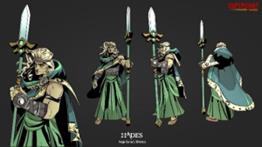1.Introduction
Since the 21st century, with the development of science and technology, cell phones, computers, and other devices have gradually become popular, and at the same time, the game company represented by Nintendo of Japan has developed generation after generation of game consoles, which has made video games gradually spread around the world and become an essential part of people’s daily life. With the development of video games, the aesthetics of the games were gradually emphasized. Game production teams strive to make games look better or have a more unique style, and many art colleges have also opened game art-related courses. However, as an emerging industry, the number of studies on game art is relatively small at this stage, and there is little literature on how to design more appealing characters in keeping with players’ aesthetic trends. In this paper, we will analyze the characteristics of characters in different kinds of games with different background settings and combine them with the art styles and gameplay of the games, as well as collect evaluations of the game from the player community, to study the methods of designing game characters quickly and effectively. We will also explore what art styles should be used for different age groups of players.
This paper will explore the trade-offs in character design and how to incorporate mythology or fictional worldviews into the characters; the overall style of the game and the style of the characters; and how the overall style of the game and the style of the characters should be used.
This paper will explore the trade-offs in character design, how to incorporate mythological or fictional worldviews into characters, and how to differentiate between overall game style and character style; the importance of costume or prop design and its impact on the game experience. As well, how to differentiate between the overall style of the game and the style of the character, the importance of clothing or props design, and its impact on the gameplay experience.
In this paper, we studied the relevant literature and summarized the data, analyzed the types of topics in the game’s fan community, interviewed some of the players about their views on the game’s art style, learned about the cultures or myths involved in the game under study, and analyzed the game’s character archetypes in light of this information.
This paper enhances the understanding of newcomers to the industry and provides a clear direction for the development of game prototypes.
2.History of Video Games
In 1958, Dr. William Higinbotham, an American physicist who was involved in the development of the world’s first atomic bomb, invented a game called Tennis for Two, which enabled the public to play tennis on oscilloscopes, and which was used for the entertainment of visitors at Brookhaven National Laboratory in Brookhaven, N.Y. This was the world’s first interactive game. In 1972, the revolutionary game Pong was born. It was released by Magnavox Odyssey, the world’s first home game console. The console with Pong was placed in a bar and attracted a large number of patrons, but too many coins caused the console to stop working, pong proved that video games could be used for financial gain, and in doing so, proved that the video game industry could be born [1].
In 1979, Activision Blizzard was founded. Four young men founded Activision Blizzard, the world’s first independent game development company.
In 1980, Toru Iwatani, a game producer for the Japanese game developer Namco, developed an arcade game called Pac-Man on the arcade platform. The game caused quite a stir at the time, having sold 100,000 in its first 15 months on the market, generating $1 billion in revenue. From the 80s to the early 90s, the video game industry was in full swing. From the arcade era into the era of home consoles, Nintendo gradually ruled the market of home consoles. At the same time, SEGA, SQUARE, ENIX, CAPCOM, and other game companies came into prominence, and a large number of classic games were born. In July 1983, the birth month of the great FC consoles, the Nintendo Entertainment System was born, which was the first attempt at a cassette-style TV gaming platform. The system was a huge success, selling over 500,000 units in two months and gaining a good reputation in the North American market. It was also around this time that the graphics of games stopped being made up of large pixelated dots and became more and more detailed. Game characters began to have concrete images, and the images of the selectable characters in CAPCOM’s Street Fighter, released in 1986, are still world-famous. In 1993, SEGA released its first 3D fighting game, VR Warriors, and in 1994, Blizzard developed and released Warcraft: Orcs & Humans, a PC-released real-time strategy game. Gradually, as game consoles and electronic devices iterated, game graphics became clearer and clearer, and many emerging technologies such as 3D modeling were utilized in video games. Many classic characters became famous around the world, such as Link the Brave in his green peaked cap and Mario the Plumber in his backpack pants and mustache, and as a result, game art, especially character design, began to be emphasized by game makers, as a successful character design often creates a deeper impression on the player [1].
3.The Importance of Game Art
When video games were in their infancy, the display of game graphics relied heavily on image data to communicate. At that time, the screen was mainly composed of pixels in a dot matrix and thus had the major disadvantage of only presenting a low-quality image with low resolution. With the iteration of display screens and computer hardware, the resolution of the game screen has been drastically increased.
3.1.Importance of Character Design
Original game art is an essential step in the development phase of a game. As games become more varied and richer in gameplay, the art required becomes more varied. Scenes, characters, weapons and props, interface, skills, and other game settings are inseparable from the game art. In between, character design is especially important, whether it’s the character controlled by the player or the NPC image in the plot, all of them can’t be separated from the character design [1]. For example, Hades, a roguelike game released by Supergiant Games, was widely loved by players because of its character design based on the Greek gods and its unique style of painting large areas in black; Hades won several awards within a short time after its release. This shows that characters with outstanding personality traits are often more eye-catching than ordinary people, and the strong and unique art style became the key to making the game stand out among its peers.
3.2.The Success of Games Like Hades
Hades is a highly recognizable indie game with an impressive art style. The game’s plot is based on Greek mythology and follows the protagonist, Zagreus, son of Hades, as he searches for his birth mother. When people think of Zagreus, they tend to think of stone statues of adult males carved with mythological stories, but Hades is the game that made Zagreus famous in the gaming world. Many experienced gamers will immediately associate the young man dressed in red, with a dog skull for armor and burning feet when they hear Zagreus [2].Another quirky example is Minecraft, a sandbox game by Mojang, whose style combines pixel dots and 3D models. Even though it doesn’t have a distinctive personality, the classic image of the player-controlled protagonist named Steve is still impressive. This is a brown-haired, dark-skinned character dressed in blue and made up of squares. His appearance is made up of pixelated dots, which fit in with the overall style of the game while portraying an explorer who is free to explore an almost infinite world. These examples exemplify the key points of character design: character design should be clear and use a limited number of elements to tell the player who the character is [3].
4.Application of Art Design in Video Games
4.1.The Connection Between the Game’s Worldview and Character Design Style
All video games have unique settings. Various styles of worlds are built into different games and are presented to the audience with distinctive architecture, backgrounds, props, enemies, and characters. Characters that fit the setting make the game feel more realistic and inspire the player to play or explore the plot.

Figure 1: Hades image [4].
According to Figure 1, Hades, a game based on Greek mythology, tells the story of the underworld, and the character design centers around the gods of Olympus [4]. Most of the Olympian gods have in-game counterparts. They wear loose Greek-style clothing and jewel-encrusted metal gauntlets. Unique elements appear on each god to display what they oversee [4].

Figure 2: Animal crossing image [5].
In contrast, in Figure 2, the game Animal Crossing is much more relaxed and suitable for players of all ages [5]. This game is set on a relaxing island where players can create a community of animals. As a result, the game’s characters are designed with cute animals in mind. The animals have colorful skins, cute or strange appearances, different personalities, and wear very individual clothes. This design undoubtedly attracted the attention of small children, making Animal Crossing one of the most popular games among young people at one time [5].

Figure 3: Detroit: become human image [5].
Like Figure 3, another game, Detroit: Become Human takes place soon [5]. The game portrays the conflict between bionics and humans and provokes readers to think about the negative effects of technological development. As a sci-fi title, the bionics in Detroit: Become Human wear standard uniforms with glowing widgets, and they have a light on their foreheads that indicates their physical condition. This design gives the first impression that they are from the future [5].
4.2.Design Ideas for Game Characters
Take, for example, games in the cyberpunk worldview. When people think of the cyberpunk world, they often associate it with glowing screens, highly sophisticated equipment, and body modifications. When designing futuristic characters, designers often install prosthetics, body modification marks, and glowing body parts on their bodies. At the same time, futuristic characters often wear slightly more saturated clothing with functional mechanical parts. In games with combat elements, characters also carry swords or guns that are related to lasers [6]. However, there is more to character design than just appearance, weapons, and clothing, and the use of color schemes is an important part of characterization. For example, red and black bring a strong sense of oppression, so many games design the leader of a monster or antagonist as a black body with a flashing red light. Yellows and oranges are pleasant and hopeful, so these colors are often found in positive and lively characters. Pink and purple give the audience a psychedelic feeling, and, these colors are often used in bars and dance halls. The shimmering pinks make it seem as if you’ve entered a drunken fantasy world.
Of course, character design will be used for more than just humans. In addition to humans, there is another kind of essential character in the game: a non-human creature. The designing of this type character is freer than designing humans because their appearance is not limited by humans. They may look like insects, animals, balls, or something unexpected. In the cyberpunk world, these creatures often come with spliced metal parts, wires, screens, and high-tech weapons. Despite the greater freedom in designing them, designers still have to follow a few rules. For example, creatures with sharp silhouettes and claws or spikes look aggressive. Rounded, heavy-looking creatures feel heavy and slow. When designing armor, designers often use a combination of geometric shapes to create a uniform image [6]. To summarize, designers should be good at grasping the impressions players have of different objects in their minds and matching those impressions to design characters. Players are more likely to empathize with characters that match their impressions, and then understand the game deeply through the characters.
4.3.The Tropes of Game Character Design
It is often said that gamers are more likely to understand characters that fit the popular image, as these characters match the tastes of the vast majority of people. However, many contrasts exist in-game characters. The world of cyberpunk has a cold feel to it because of the enormous class gap in it. People often think of cold robot cops when referring to cyberpunk. These robotic cops are often armed with taser batons, painted a uniformly dark color, and numbered with spray paint. Imagine a pink guy jumping out of a crowd of Robocops and enthusiastically guiding the player to a shelter [7]. At times like these, a distinctive character makes a lasting impression on the player. It goes against the cold image of the police and makes the player think about the character’s backstory. Occasionally, counter-intuitive character design can effectively cut down on the stereotypes of NPCs in the player’s mind, and effective use of this technique can instead whet the player’s appetite for exploring the game.
5.Conclusion
To some extent, the progress of game art and games is complementary. Character design is an extremely important part of game art, and it is by no means as simple as drawing some characters at will. All famous game characters must have their unique characteristics, and it is difficult to attract players for a long time. How the game character designer cleverly uses different elements to shape the character to largely determine the degree of the character’s acceptance of the player and the popularity of the game. The shortcomings of this article are that there are not many data collected, and the style of the character design cannot be observed in the data. In the future research, the data containing the game market survey and analyzing the user group attracted by different art styles in similar backgrounds based on data analysis, and add more charts to assist in description.
References
[1]. Yukun Gong & Yuzhe Huang.(2023). A Stylistic Study of Game Character Original Design. Journal of Dali University (07),87-93+129.
[2]. Junxi LI.(2021). Research on the Design Concept of Character Drawing in Game Art (Master’s Thesis, Wuhan University of Technology)).https://kns.cnki.net/KCMS/detail/detail.aspx?dbname=CMFD202301&filename=1022723357.nh
[3]. Bi Zhao.(2010). Research on Character Design of Video Game Characters (Master’s Thesis, Kunming University of Science and Technology).https://kns.cnki.net/KCMS/detail/detail.aspx?dbname=CMFD2012&filename=1011053760.nh
[4]. Xin Pan.(2021). Research on Character Design Elements in Game Original Painting. Art View (32),46-48.
[5]. Zhongqiang Wang.(2019). Characterization and Derivation of Classical Artistic Images in Game Aesthetics (Master’s Thesis, Dalian University of Technology).https://kns.cnki.net/KCMS/detail/detail.aspx?dbname=CMFD202001&filename=1019693756.nh
[6]. Yue Yu.(2020). Research on the Elements and Technical Performance of Contemporary Game Character Design (Master’s Thesis, Liaoning Normal University).https://kns.cnki.net/KCMS/detail/detail.aspx?dbname=CMFD202002&filename=1020731860.nh
[7]. Shuqi Luo.(2018). . The study of characterization in video games. Communication World (12) (12),253-254.
Cite this article
Kou,Y. (2023). An Analysis of Character Design in Video Games. Communications in Humanities Research,14,186-191.
Data availability
The datasets used and/or analyzed during the current study will be available from the authors upon reasonable request.
Disclaimer/Publisher's Note
The statements, opinions and data contained in all publications are solely those of the individual author(s) and contributor(s) and not of EWA Publishing and/or the editor(s). EWA Publishing and/or the editor(s) disclaim responsibility for any injury to people or property resulting from any ideas, methods, instructions or products referred to in the content.
About volume
Volume title: Proceedings of the International Conference on Global Politics and Socio-Humanities
© 2024 by the author(s). Licensee EWA Publishing, Oxford, UK. This article is an open access article distributed under the terms and
conditions of the Creative Commons Attribution (CC BY) license. Authors who
publish this series agree to the following terms:
1. Authors retain copyright and grant the series right of first publication with the work simultaneously licensed under a Creative Commons
Attribution License that allows others to share the work with an acknowledgment of the work's authorship and initial publication in this
series.
2. Authors are able to enter into separate, additional contractual arrangements for the non-exclusive distribution of the series's published
version of the work (e.g., post it to an institutional repository or publish it in a book), with an acknowledgment of its initial
publication in this series.
3. Authors are permitted and encouraged to post their work online (e.g., in institutional repositories or on their website) prior to and
during the submission process, as it can lead to productive exchanges, as well as earlier and greater citation of published work (See
Open access policy for details).
References
[1]. Yukun Gong & Yuzhe Huang.(2023). A Stylistic Study of Game Character Original Design. Journal of Dali University (07),87-93+129.
[2]. Junxi LI.(2021). Research on the Design Concept of Character Drawing in Game Art (Master’s Thesis, Wuhan University of Technology)).https://kns.cnki.net/KCMS/detail/detail.aspx?dbname=CMFD202301&filename=1022723357.nh
[3]. Bi Zhao.(2010). Research on Character Design of Video Game Characters (Master’s Thesis, Kunming University of Science and Technology).https://kns.cnki.net/KCMS/detail/detail.aspx?dbname=CMFD2012&filename=1011053760.nh
[4]. Xin Pan.(2021). Research on Character Design Elements in Game Original Painting. Art View (32),46-48.
[5]. Zhongqiang Wang.(2019). Characterization and Derivation of Classical Artistic Images in Game Aesthetics (Master’s Thesis, Dalian University of Technology).https://kns.cnki.net/KCMS/detail/detail.aspx?dbname=CMFD202001&filename=1019693756.nh
[6]. Yue Yu.(2020). Research on the Elements and Technical Performance of Contemporary Game Character Design (Master’s Thesis, Liaoning Normal University).https://kns.cnki.net/KCMS/detail/detail.aspx?dbname=CMFD202002&filename=1020731860.nh
[7]. Shuqi Luo.(2018). . The study of characterization in video games. Communication World (12) (12),253-254.









